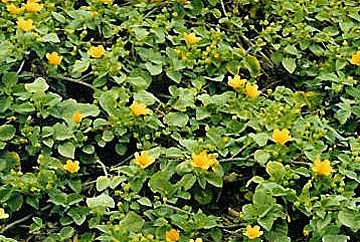
|
In The Garden
Rick Barboza
|
'Ilima papa grows well as ground cover in dry soil

HUI KU MAOLI OLA
'Ilima Papa
Ground cover 'Ilima
Sida fallax
|
|
Prostrate plants with pale green leaves, woody stems and bright orange flowers. The many varieties of 'ilima have the same botanical name but appear quite different. Some grow into bushes while others, such as this one, lie flat. Even leaves and flowers can look different between varieties.
Distribution: 'Ilima papa is found naturally on all the Hawaiian islands and many other places in the Pacific. All grow near the ocean in what is called the "strand vegetation" zone. Here, plants are exposed to extremely harsh conditions such as salt spray, wind, intense sun and heat, and drought. Plants that occupy this vegetation zone generally share the same physical characteristics as mentioned above.
Landscape use and care: Plant 'ilima papa as a ground cover anywhere that has full sun, is pretty dry and has nonclay soil.
Space the plants 1 1/2 to 2 feet apart. Do not overwater. The best thing to do is to soak the ground and not water again until the soil has completely dried. If you water too much, you'll notice that the plants will get quite tall, especially if planted too close. Eventually the leaves will start to yellow, even droop, which is a sign often mistaken for drying out, so people add more water to the already drowning plant. If you notice this happening, feel the soil first. If it's still moist, let it dry out.
Mealybugs, usually brought by ants, sometimes feed on this plant, as do whiteflies. Get rid of ants with granular pesticide, and treat the plant with any store-bought pesticide that specifically kills mealybugs and whiteflies.
Slugs and snails also like to live under ground covers, so if you know your area has slugs or snails (the big African kind, not the endangered Hawaiian kind), treat the area with slug and snail bait.
These plants are available at Home Depot for only $3.97 in 1-gallon pots.
Uses: 'Ilima is the island flower of Oahu and is used to make leis. The flowers can also be used as a mild laxative for babies. You can even put some in a tossed salad to add color -- pinch them out of their calyxes (the small green cup from which the petals emerge) -- and don't worry about the laxative part, it works only on babies.
Rick Barboza co-owns Hui Ku Maoli Ola, a native Hawaiian plant nursery. Contact him at 259-6580 or e-mail
rickckbarboza@aol.com. "In the Garden" is a Friday feature.
Rick Barboza co-owns Hui Ku Maoli Ola, a native Hawaiian plant nursery, with Matt Schirman. Contact him at 259-6580 or e-mail
rickbarboza@aol.com.

